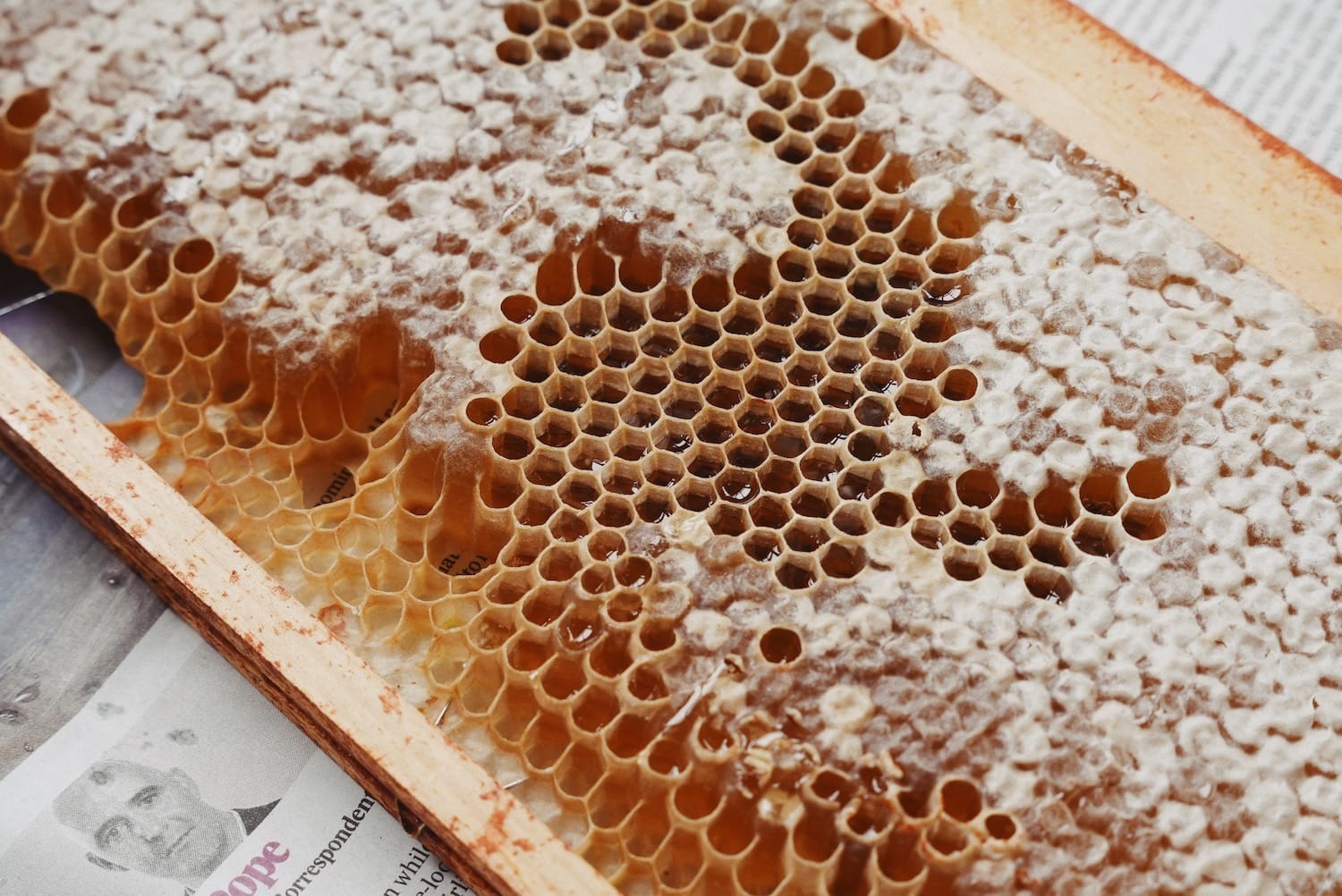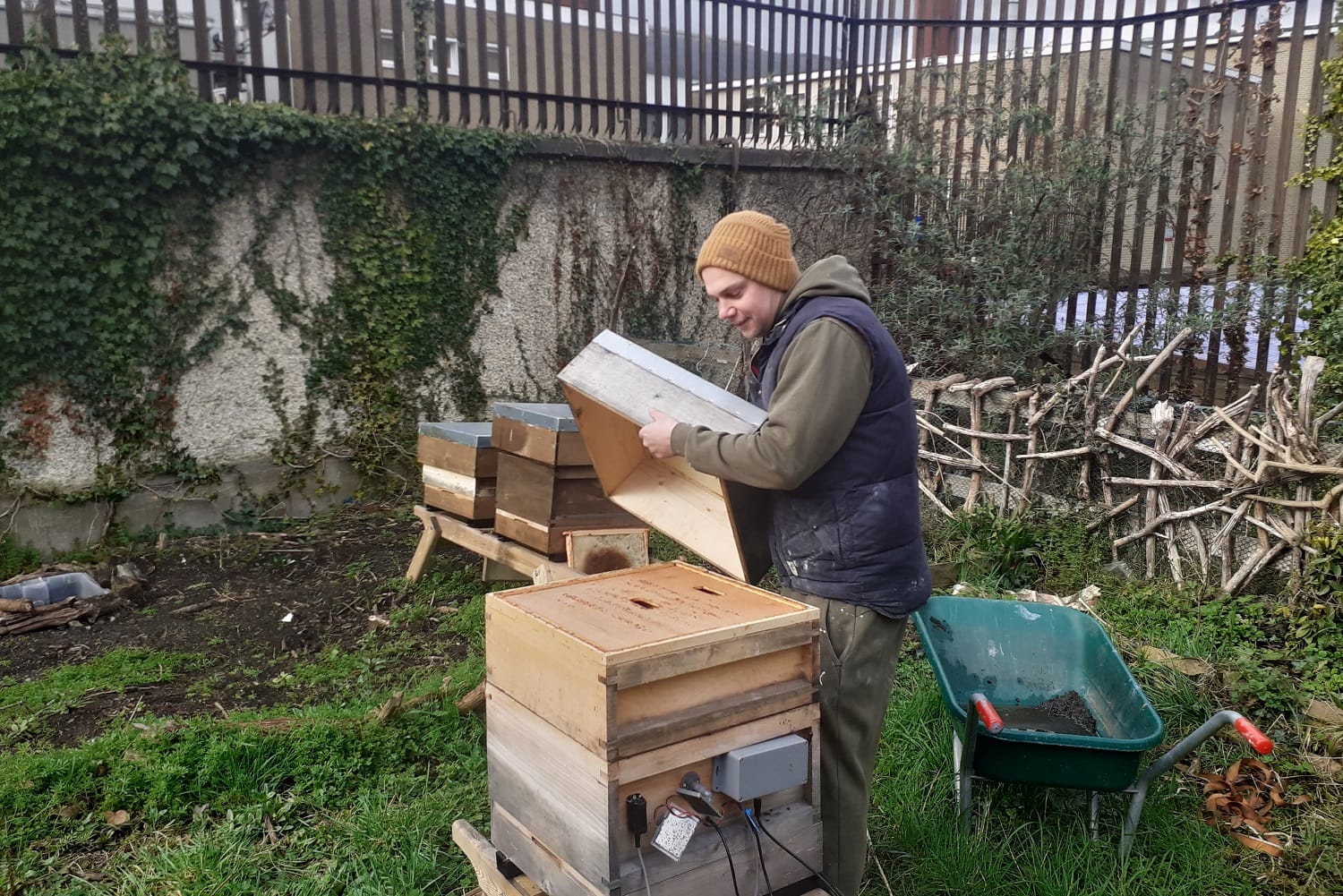What’s the best way to tell area residents about plans for a new asylum shelter nearby?
The government should tell communities directly about plans for new asylum shelters, some activists and politicians say.
“Too many honeybees can negatively impact wild bees in the vicinity,” says Úna FitzPatrick, a senior ecologist for the National Biodiversity Data Centre.

When he got his first hives about three years ago, Kevin Breen was thinking about honey, not about biodiversity.
The retired former plumber had met someone who was keeping bees to make “natural” honey – unpasteurised, unprocessed – and wanted to do the same.
On a recent Tuesday, about midday, Breen, grey-haired, sat on the couch in the front room of his house in Perrystown, holding his shiny black cane and talking bees.
“The honeybee is a bit of an idiot,” he says, sitting on a black couch with yellow cushions. “They just have this desire to make more and more honey.”
He keeps his bees in the long grassy backyard at his sister Maeve Elliott’s house, just a short drive up the road.
That Tuesday afternoon, they were buzzing in and out of holes in the front of four waist-high yellow and white hives, set under a roof to keep the rain off. “Just don’t step in front of the hives or they might get a bit narky with you,” he says.
Among the hives stands a machine – the size of a very large dog or a very small horse – which Breen built using his plumbing skills to blow hot air onto the hives to kill off mites that attach to the bees and run down their immune systems, he says.
Breen sees his hives as doing only good for the area, his bees flying off on expeditions to the neighbours’ yards, making everything flower and fruit more bountifully.

But Úna FitzPatrick, a senior ecologist for the National Biodiversity Data Centre, says honeybee hives like these might be doing harm to the survival of the wider bee population. “Too many honeybees can negatively impact wild bees in the vicinity.”
“If you’re bringing a hive of honeybees into an area they’re then out there trying to find food, to feed their young,” FitzPatrick says. “Competing with wild bees trying to do the same.”
A third of Ireland’s species of wild bees are in decline and are at risk of extinction, she says.
There are 98 species of wild bee – 77 of solitary bee and 21 of bumblebee – according to the All Ireland Pollinator Plan 2021–25, which FitzPatrick helped develop.
“Research has shown that more than half of Ireland’s bee species have undergone substantial declines in numbers since 1980, with 30% of species considered threatened with extinction from Ireland,” it says.
Cities can be great environments for wild bees, says FitzPatrick.
“You get a lot of diversity, lots of pockets of land use, parks and gardens, and don’t get the same chemical use as in rural landscapes,” she says.
Kaethe Burt-O’Dea, who looks for bees as an amateur and runs the shop Bí Urban in Stoneybatter, which sells eco-friendly products, says that a few years ago she found a colony of wild bees in a wall on New Church Street in Smithfield.
It’s easier than people might think to find bees in cities, she says.
However, the lack of food in the Irish landscape is the key part of the decline, FitzPatrick says. “There aren’t enough flowers.”
Which is what the All-Ireland Pollinator Plan is meant to address, she says. “To bring flowers back into the landscape.”
For wild bees to thrive in the city, people should plant flowers and herbs, or start a community garden, she says.
“It’s so important that we don’t inadvertently have a negative impact with too many honeybee hives,” she says.
There’s only one species of honeybee in Ireland, but there are lots of them – mostly living in hives, but also in the wild, says the All-Ireland Pollinator Plan 2021–25.
“While honeybees face many threats, including pesticides and disease, honeybees are not endangered in Ireland but are actually increasing,” it says.
From 2016 and 2019 the number of beekeepers in Ireland increased by 41 percent, to 4,462, according to a spokesperson for the Department of Agriculture. Over same period, the number of bee colonies increased by 26 percent, to 27,040, he said.
“Though there are many commercial beekeepers, the vast majority of beekeepers in Ireland are hobbyists with small apiaries,” the spokesperson said. County Cork had the most beekeepers and colonies, and Dublin was second, he said.
When honeybees die, beekeepers can just buy more, she says, but the same isn’t true for the other kinds of wild bees, says FitzPatrick.
A honeybee hive can have 50,000 bees in the summer, while the largest bumblebee nest might be around 400, she says.
Ireland needs diversity in its bee population, FitzPatrick says. “We have to be careful to get that balance.”
Because we rely on wild bees to pollinate fruits and vegetables, which allows the plants to continue growing, she says.
“It’s an important service we need them to provide. The more types [of bees] we have the better,” she says.
All bees are needed, but beekeepers look after honeybees more because of their honey, she says.
Breen, the Perrystown beekeeper, says he’s surprised by the idea that hive honeybees might crowd out wild bees, and has trouble believing it.
“You see different types of bees on the same plant and they don’t bother each other,” he says.
His sister, Elliott, is sceptical too. “All that’s debatable, I guess.”

Ken Norton, secretary of the Federation of Irish Beekeepers Associations, is also sceptical that this is a problem.
“There is plenty of info on the All Ireland Pollinator Plan and National Biodiversity Data Centre websites and nothing to back up the misconception that the honey bee and beekeepers are responsible for any decline” in wild bees, he said by email.
Research done on Montreal in Canada in 2021 found that bringing more honeybees hives can negatively impact on the wild bees in some areas. But Norton says: “Like most things what happens elsewhere with bees is not the same as in Ireland.”
The research looked at the influence of honeybees, the same species that is here in hives in Ireland, on wild bee populations.
“Urban beekeeping is commonly perceived as an environmentally friendly practice or a way to combat pollinator declines, when high-density beekeeping operations may actually have a negative influence on native and wild bee populations,” says a resulting paper.
So should people stop keeping honeybees then, if they harm the prospects of survival for wild bee populations?
It’s necessary to regulate beekeeping in areas with high densities of rare wild bees, says FitzPatrick.
That is also a suggestion from the authors of the Montreal bee study. “The creation of more evidence-based frameworks to regulate urban beekeeping operations are paramount to develop sustainable beekeeping operations while protecting wild pollinator diversity in cities,” their paper says.
It’s not that people should stop keeping honeybees, FitzPatrick says. If they want to, for a hobby, and for honey, that’s grand, she says.
“It’s more that there can be a misconception that it’s a biodiversity action or the best way to combat pollinator declines,” she says.
The authors of the Montreal study write that “To support our native bees and encourage ecologically responsible urban beekeeping, introductions of honey bee colonies could be accompanied by deliberate planting of flowers known to provide abundant pollinator resources, especially those preferred by more vulnerable or specialist bee species.”
On a recent Friday in Dublin, Anthony Freeman O’Brien unlocked the tall steel gate on Watling Street in the Liberties, where he keeps three of over 60 beehives around the city of the Digital Hub’s Bee8 project.
They stand at the end of the small walled green space, which has a shed, a teepee for mindfulness sessions, and a small plot with growing herbs and plants.
He points at the small shrubs, from which a faint fragrance emits. “I’ve thyme here, rosemary. There’s mint over there.”

Since hearing about the new research last summer he’s starting to plant herbs so that there will be more food available for the bees.
Freeman O’Brien has drilled holes into the fence, and added a layer of soil and moss to the roof of the shed.
“We’ve had a colony of bumblebees in here,” he says, pointing to the grassy ground, then to the top of a building walling the south end. He’s hoping the same colony will return and take refuge in the shed roof.
Paul Handrick, who runs the Bee Sanctuary of Ireland in County Wicklow – no hives, no honey, just wild bees – with his partner, says the way to get a healthy, diverse bee population is simple.
If people want to keep bees for honey or a hobby, that’s fine, he says. But for anyone who’s worried about bees, and pollinators in general, and biodiversity, there’s no need for hives or bee hotels or any special kit, says Handrick, who goes by “The Bee Guy”.
“There’s a lot of BS and misinformation that goes there and we just sit there looking at it going, ‘Oh would someone just tell the truth’,” he says.
“Let your garden grow a little wild, let your grass grow long, get a beer, sit back in the garden and watch the bees arrive.”
UPDATE: This article was updated at 10.47am on 12 April 2023 to include figures on growth in beekeepers and hives from the Department of Agriculture.
Get our latest headlines in one of them, and recommendations for things to do in Dublin in the other.